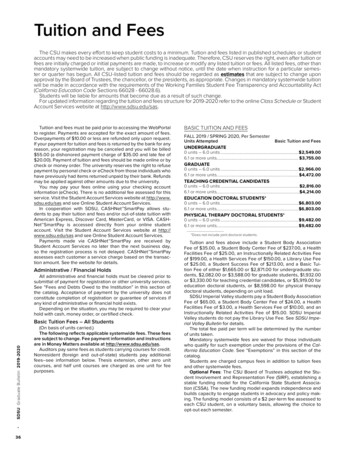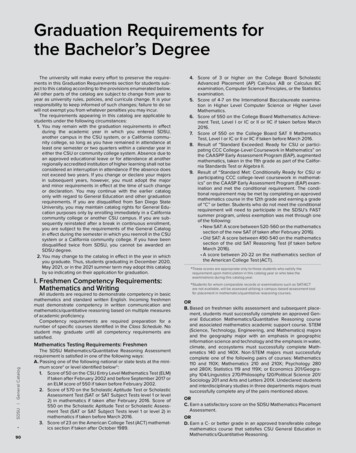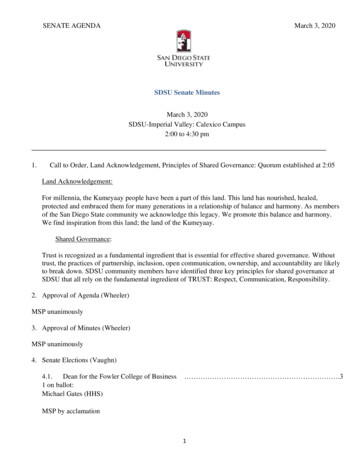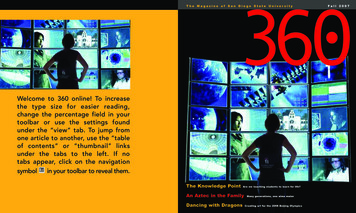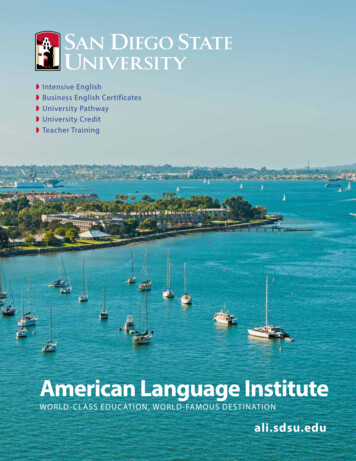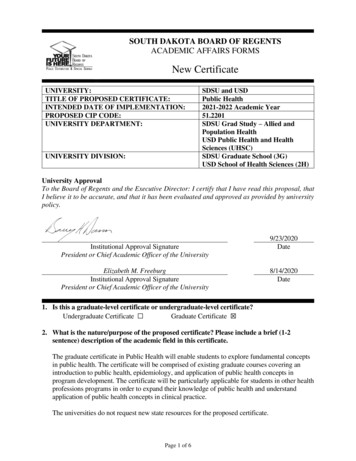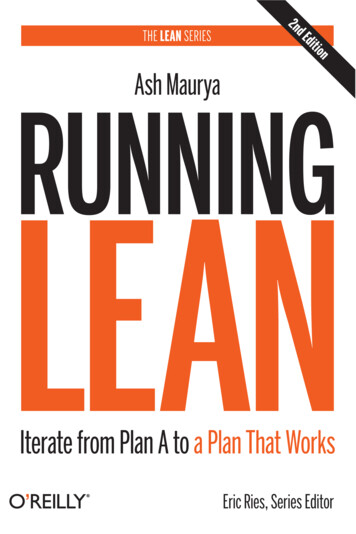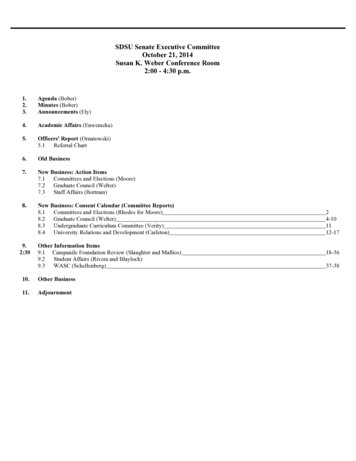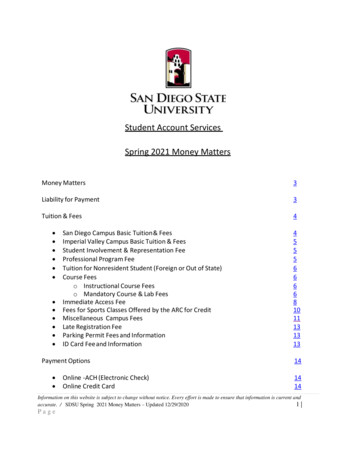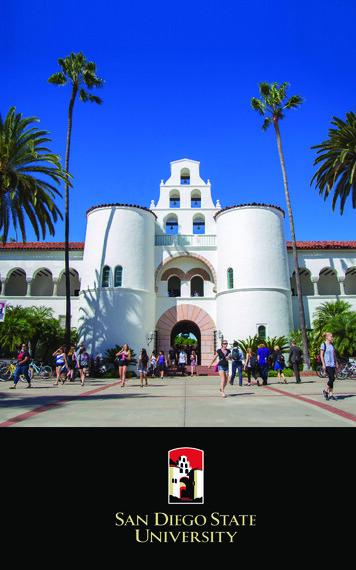
Transcription
ABOUT SDSUFounded in 1897, San Diego StateUniversity is a public institutionof higher education in southernCalifornia. Part of the 23-campusCalifornia State Universitysystem, SDSU is one of thelargest universities in the statewith more than 33,000 students.SDSU continues to gain recognitionas a leader in higher education.It is currently ranked in the top150 national universities andin the top 75 public universities,according to U.S. News & WorldReport’s annual ranking ofAmerica’s Best Colleges.OUR CAMPUSOtherwise known as MontezumaMesa, our campus is a placewhere mission-style buildings arespread over 280 acres of lushlylandscaped grounds intercut withhills and canyons. Although thecampus is large, you can walkacross campus in just 20 minutes.SDSU is northeast of downtownSan Diego, just off Interstate 8and conveniently located alongthe San Diego Trolley Green Line.VISIT SDSUJoin us on campus by schedulinga tour at www.sdsu.edu/campustour. Can’t make it tocampus? Take a virtual tourany time at www.sdsu.edu/virtualtour.1
SAN DIEGOThe second largest city in California, San Diego is a thriving cultural,scientific, and educational center. Our proximity to the Pacific Rim andMexico and our diverse regional population provide opportunities forvaluable work and learning experiences.Known for its near-perfect climate, miles of sandy beaches, and funfilled waterfront activities, our region is home to a wide range ofindustries, from engineering and biotechnology to agriculture andtourism. The hustle and bustle of the Gaslamp Quarter and downtownneighborhoods is complemented by the charming and eclectic beachtowns of Pacific Beach, Ocean Beach, and La Jolla.With all the amenities for living, working, and playing, it’s no wonder SanDiego is nicknamed “America’s Finest City!” Learn more about San Diegoat www.sandiego.org.HOW CLOSE?10 miles.Beaches10 miles.Downtown50 miles.Mountains75 miles.Deserts95 miles.Disneyland120 miles.Los Angeles350 miles.Phoenix500 miles.San FranciscoLa Jolla CoveScripps Birch AquariumMission TrailsRegional ParkPacific BeachLake MurrayQualcommStadium(Aztec Football)Mission BayAquatic CenterMission BeachSea WorldFashionValley MallSDSUOcean BeachSan DiegoInternational AirportCALIFORNIASunset CliffsDowntown and Gaslamp QuarterConvention CenterRedwoodNational ParkLake TahoeSacramentoSan FranciscoBalboa Park and San Diego ZooPoint LomaPetco ParkCoronadoYosemiteMontereyNeighborhoodsand AttractionsSanta BarbaraTrolley LineLos Angeles2 miSAN DIEGO5 km4
FASTFACTS33,778students enrolled, including29,046 undergrads and4,732 gradsNo. 3in the West of best affordablecolleges according to GreatValue Colleges88students have received Fulbrightawards, making SDSU a topproducer in Fulbright winnersNo. 7nationally for ethnicdiversity according toU.S. News and World ReportNo. 8among public universities forundergraduate entrepreneurialprograms according to U.S.News and World Report 815Mraised in the Campaign forSDSU to support scholarships,endowed professorships,academic programs, newcampus buildings, and athleticsNo. 9in the nation for the numberof students studying abroad,in the latest Institute forInternational Education’s OpenDoors report, with a recordnumber of 2,660 studentsstudying abroad6
MAJORSAt SDSU, we are committed to creating educational opportunities that contribute tointellectual development and equip you to succeed in a global society. All incomingstudents receive a four-year plan giving them a clear road map to graduation.Find the plan for your major at www.sdsu.edu/mymap. For more informationabout majors, emphases, and minors, visit www.sdsu.edu/majors.ARTS AND LETTERS Africana Studies American Indian Studies Anthropology Asian Studies Chicana and ChicanoStudies Classics ComparativeInternational Studies Comparative Literature Economics English European Studies French Geography German History Humanities International Business International Securityand Conflict Resolution Japanese Latin American Studies Lesbian, Gay, Bisexualand Transgender Studies Linguistics Modern Jewish Studies Philosophy Political Science Religious Studies Russian Russian and CentralEuropean Studies Sociology Spanish Sustainability Urban Studies Women’s Studies7BUSINESSADMINISTRATION Accounting Entrepreneurship Finance Financial Services Human ResourceManagement Information Systems Management Marketing Real EstatePROFESSIONAL STUDIESAND FINE ARTS Child and FamilyDevelopment Liberal Studies (forelementary teachers) Art Communication Criminal JusticeAdministration Dance Hospitality and TourismManagement andRecreation Administration Journalism and MediaStudies—Public Relations,Advertising Music Public Administration Television, Film, andNew Media Theatre ArtsENGINEERINGSCIENCESEDUCATION Aerospace Engineering Civil Engineering Computer Engineering Construction Engineering Electrical Engineering Environmental Engineering Mechanical EngineeringHEALTH ANDHUMAN SERVICES Athletic Training Foods and Nutrition Gerontology Health Science Kinesiology—Fitness Specialist andPre-Physical Therapy Nursing Public Health Social Work Speech, Language, andHearing Sciences Astronomy Biology Chemical Physics Chemistry Computer Science Environmental Sciences Geological Sciences Mathematics Microbiology Physical Science Physics Psychology StatisticsPREPROFESSIONAL PROGRAMSAre you interested in attending a professional school after graduation? SDSU’spreprofessional programs are not majors, but help prepare you to continue yourstudies in the following career fields: Predental Prelegal Premedical Preoptometry Prepharmacy Prephysician Assistant PreveterinaryYou may learn more about a preprofessional program by contacting the programadviser. For more information, visit www.sdsu.edu/preprof.UNDERGRADUATESTUDIES Undeclared8
STUDENT SUCCESSWEBER HONORS COLLEGEAs one of SDSU’s most academically engaged undergraduate students, youwill benefit from small, discussion-based classes and innovative teachingtechniques which promote inquiry and discovery. Study abroad opportunitiesand residential community experiences in the Weber Honors ResidentialCollege enable you to reach beyond the boundaries of your academic major.To learn more about the requirements and applying for the WeberHonors College, visit www.sdsu.edu/honors.RESEARCHIf you’re driven by the thrill of discovery, prepare to conduct researchalongside history-makers at SDSU. Our students, faculty, and alumnihave been part of research teams that advance the commercializationof potential clean energy solutions, use fruit flies as a model to identifyimportant pathways that promote the repair of the nervous system, andestablish successful businesses on a regional, national and global scale.To read these stories and more, go to newscenter.sdsu.edu andclick Research.STUDY ABROADJoin more than 2,600 students each year who experience the excitementand rewards of studying in another country. SDSU offers nearly 400study abroad programs in 67 countries. These programs offer you theopportunity to learn a new language, experience a different culture, buildyour resume, and increase earning potential.Visit www.sdsu.edu/studyabroad to find the right program for you.CAREER DEVELOPMENTSDSU strives to help all students find their dream careers through amultitude of internships, career services, and mentoring programs.SDSU also offers extensive internship programs including the Divisionof Undergraduate Studies (DUS) Internship Program, which connectsstudents with businesses in the San Diego area or with departmentalinternships on campus.9SDSU’s Career Services hosts multiple career fairs throughout the year toconnect students with on- and off-campus employers. Career Services alsoaids students in developing and refining their resumes and interviewingskills. Explore the available resources at career.sdsu.edu.10
ADMISSIONSFRESHMAN ADMISSION CRITERIASDSU attracts highly qualified students each year. The average high schoolGPA for fall 2017 admitted freshmen was 3.87 with an average SAT (evidencebased reading and writing, and math) score of 1229 or ACT score of 26.8.You can apply as a freshman as long as you haven’t graduated high school,but are on track to graduate with a high school diploma by spring 2018, oryou haven't taken any college-level courses beyond the summer after yourhigh school graduation. Before you apply, visit the online application guide atwww.sdsu.edu/freshmanapplicant and then apply at calstate.edu/applybetween October 1 and November 30, 2017 for fall 2018 admission.Your application is evaluated based on:1. Your Eligibility Index (a calculation of your GPA and SAT/ACT scores)2. Completion of the “A–G” college prep curriculum3. Your intended majorELIGIBILITY INDEXThe eligibility index is based on your GPA and your scores on either theSAT (evidence-based reading and writing, and math), or the ACT. Neitherwriting scores nor subject tests are considered for admission. For moreinformation on the eligibility index, visit www.sdsu.edu/eligibilityindex.Calculating your GPAFor the SDSU admissions application, your high school grade point averageis calculated on all “A–G” courses completed after ninth grade. This meansit may be different than the GPA* on your high school transcript. Refer towww.sdsu.edu/eligibilityindex to learn how to calculate your GPA.Calculating your Eligibility IndexOnce you have calculated your GPA, refer to the formula onwww.sdsu.edu/eligibilityindex to calculate your eligibility index.INTENDED MAJORAll majors have more applicants than available slots (the CSU calls thisimpaction). During admission, we rank applicants within each major, rather thanoverall. Music, dance and theatre arts (performance) applicants will receivefurther instructions from the department regarding additional requirements.Admission to nursing is a highly selective process. Freshman nursingapplicants will be ranked by their GPA on college preparatory courses, SAT/ACT scores (see SAT/ACT information under Eligibility Index), and gradesin high school intermediate algebra, biology and chemistry with a lab.11*AP courses are eligible for honors points.A–G COURSESAs a first-time freshman applicant, you must earn a C- or higher in thefollowing 15-unit “A–G” pattern of college preparatory courses:A. Social Science—2 yearsMust include 1 year U.S. history and government.B. English—4 yearsAcceptable courses must include substantial reading of classic/modernliterature and writing of structured papers.C. Mathematics—3 years (4 recommended)Acceptable courses include algebra I, geometry, and algebra II.D. Laboratory Science—2 yearsMust include 1 year of a biological science and 1 year of a physical science.E. Foreign Language—2 years or demonstrated equivalent competenceBoth years must be in the same language.F. Visual and Performing Arts—1 yearMust be a year-long course in visual art, dance, drama/theatre, or music.May complete two semester-long courses from the same discipline.G. Electives—1 yearSelect from English, advanced mathematics, social studies, history,laboratory science, agriculture, or foreign language.12
Transfer PathwaysWhen you apply to SDSU as a transfer student, you must select the majorthat you are going to pursue. For a complete list of majors offered at SDSU,visit www.sdsu.edu/majors. When you are considering which major tochoose, review the transfer admission requirements carefully as somemajors have special instructions.After you have selected a major, determine which pathway you will followfor admission. The following pathways are offered at SDSU:ADMISSIONS Associate Degree for Transfer (ADT) Transfer Admission Guarantee (TAG) General Transfer PathwayTRANSFER ADMISSION CRITERIAFor more information, visit www.sdsu.edu/transferapply.SDSU accepts transfer applications* only from upper-division transferstudents who have completed 60 or more transferable semester (or 90 ormore quarter) units by the end of the spring term prior to enrolling at SDSUfor the following fall semester.All applicants will be admitted on a space-available basis and will be rankedon how closely they meet the five requirements below. An additional overallGPA may be required.Online Resources SDSU Admissions—www.sdsu.edu/transferapply Transfer Admission Planner—www.sdsu.edu/tap ASSIST—www.assist.org Major Academic Plan—www.sdsu.edu/mymap SDSU General Catalog—www.sdsu.edu/catalogTransfer Admission RequirementsAs an upper-division transfer applicant, you must meet the followingminimum requirements by the end of the spring** term prior to enrollingat SDSU for the following fall semester to be considered for admission: Complete a minimum of 60 or more transferable semester (or 90 ormore quarter) units. Complete a minimum of 30 units of General Education courses. Complete with a C- grade or higher, the following General Educationcourses, known as the “Golden Four.” For detailed information about theGolden Four, visit www.sdsu.edu/transferapply.a. Oral Communicationb. Written Communicationc. Critical Thinkingd. Mathematics Meet the GPA*** required for your major at www.sdsu.edu/majorgpa. Complete all major preparation courses listed in the SDSU General Catalog.* SDSU does not accept transfer applications from lower-division students with fewer than 60 transferablesemester units nor for a second bachelor’s degree except in nursing.** Upper-division nursing transfer applicants must complete all nursing prerequisites by the end of the fall term.*** If you have prior SDSU coursework, you must maintain a 2.0 or higher GPA for any SDSU Regular Session, Special13 Session, Open University, or Cross Enrollment coursework. This is in addition to the major GPA requirement.APPLYINGHOW TO APPLYSDSU’s application filing period is October 1 to November 30 for admissionthe following fall. Before you apply, visit the online application guide atwww.sdsu.edu/transferapplicant and then apply at calstate.edu/applyand designate San Diego State University as your campus of choice.ONLINE SDSU SUPPLEMENTAL APPLICATIONTransfer applicants must submit the mandatory online SDSU SupplementalApplication on the SDSU WebPortal in January 2018.Admission is based on self-reported information. SDSU will verify thisinformation against your official transcripts after you are admitted.ADMISSION STATUSAdmission decisions will be available via your SDSU WebPortal accountstarting in March. Be sure to set up your SDSU WebPortal account atwww.sdsu.edu/portal in December to view your admission status.14
COST OF ATTENDANCEYour college educationis a valuable investmentin your future. With theincreasing cost of highereducation across thecountry, it is importantto make informedchoices to make thisinvestment affordablefor you and your family.UNDERGRADUATE COSTS (2017–18)We want you tounderstand what yourcosts will be so that youcan make importantdecisions as youprepare for the nextstep in your tate)Basic Tuitionand Fees 7,460 7,460NonresidentTuition* 0 11,880On-Campus Foodand Housing** 15,966 15,966Total*** 23,426 35,306For the most up-to-date figures, or forinformation on graduate tuition and fees,refer to www.sdsu.edu/admissions/fees.* Nonresident tuition is based on 15 units each semester at 396 per unit.COST CALCULATORSDSU’s Net Priceand Cost Calculatorhelps you estimateyour eligibility forundergraduate federalgrants and loans andthe approximate netprice you and yourfamily should expectto pay using yourown funds. Visitwww.sdsu.edu/costcalculator formore information.** All first year students who graduate from high school outside ofSDSU’s local admission area in spring of 2018 will live on campus fortwo years. Be sure to review the on-campus food and housingpayment schedule at www.sdsu.edu/housing. This estimate is based ona double room and the Flex 7 meal plan. Your total cost and paymentswill vary depending on the meal plan and room type you are assigned.*** Plan for additional expenses that will increase your cost ofattendance. For undergraduates, we estimate the average annual costof books and supplies to be 1,854, transportation to be 1,494, andpersonal expenses to be 1,450. If these amounts match your personalsituation, then add them to the overall cost of attendance listed above.Cost of Attendance Note: The CSU makes every effort to keep studentcosts to a minimum. Fees listed in published schedules or studentaccounts may need to be increased when public funding is inadequate.Therefore, CSU must reserve the right, even after fees are initiallycharged or initial fee payments are made, to increase or modify anylisted fees. All listed fees, other than mandatory systemwide fees, aresubject to change without notice, until the date when instruction for aparticular semester or quarter has begun. All CSU listed fees shouldbe regarded as estimates that are subject to change upon approval bythe Board of Trustees, the Chancellor, or the Presidents, as appropriate.Changes in mandatory systemwide fees will be made in accordance withthe requirements of the Working Families Student Fee Transparency andAccountability Act (Sections 66028-66028.6 of the Education Code).16
PAYING FOR YOUR EDUCATIONGet an overview of how to pay for your education at www.sdsu.edu/admissions/fees and the financial aid process at www.sdsu.edu/financialaid. Once you have applied for aid, access AidLink at www.sdsu.edu/AidLink to check on the status of your financial aid application.FINANCIAL AIDAny time after October 1, you can apply for financial aid—don’t wait untilyou are admitted to the university! The Free Application for Federal StudentAid (FAFSA) is all you need to be considered for federal grants, student andparent loans, and work study. Apply online at www.fafsa.gov using SDSU’sFederal School Code of 001151.DeadlinesMarch 2 is the Cal Grant deadline and we encourage all students to completethe FAFSA by this date. Be sure to check AidLink to determine if you need tosubmit additional documentation and for the priority evaluation deadline.IRS Data RetrievalWe strongly recommend that you use the IRS Data Retrieval processwhen submitting your online FAFSA. Actual income and tax informationis automatically transferred from the IRS to your application reducing errorsand the need to follow up for additional information.A scholarship is a monetary award usuallygiven to students based on their achievementsand qualifications.Types of ScholarshipsSDSU Scholarships: SDSU scholarships arecompetitive and each requires a separateapplication. Most are due in early February,but it is strongly encouraged to apply forSDSU scholarships as soon as you haveapplied for admission to the university. First,search for scholarships at www.sdsu.edu/scholarshipsearch. Then submit yourscholarship application, essay, and anyadditional materials. Review the application andeligibility requirements in each scholarship’sdescription for more details.Academic departments may offer additionalscholarships, fellowships, and traineeships.External Scholarships: We encourage youTypes of Aidto apply for as many scholarships as possible.External scholarships may be awardedto students at any university. They aremanaged by organizations other than SDSU.Federal Pell Grants: Pell Grants are awarded based on financial need anddo not have to be repaid.Scholarship ResourcesLoans: Federal loan programs allow you to borrow funds for your educationthat you will repay after graduation at a low interest rate. A freshman mayborrow up to 5,500 in federal loans. Parents may borrow up to the totalcost of attendance after passing a credit evaluation for a Federal ParentPLUS Loan. Alternative loans, offered by private lenders, are more expensive.Borrow your limit in federal loans before seeking a private loan. Ask about scholarships from your
** Upper-division nursing transfer applicants must complete all nursing prerequisites by the end of the fall term. *** If you have prior SDSU coursework, you must maintain a 2.0 or higher GPA for any SDSU Regular Session, Special
